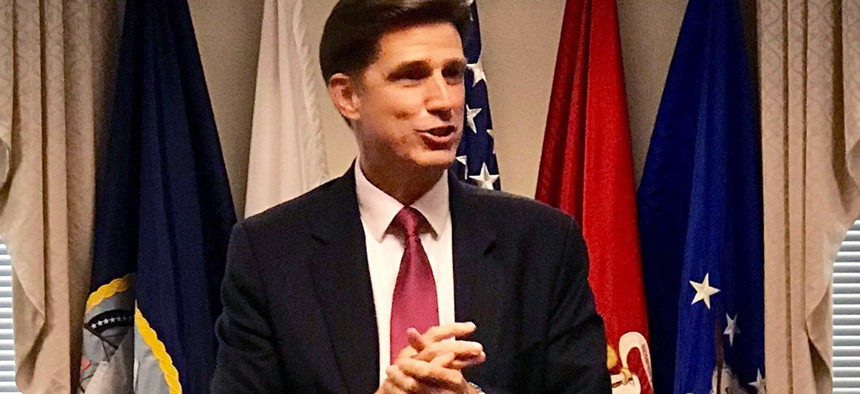What DOD’s Change In Cloud Leadership Means For Multibillion-Dollar Programs

Dana Deasy, Defense Department CIO Defense Department
The Defense Department’s management chief Jay Gibson discusses the evolving Cloud Executive Steering Group.
The Defense Department is shifting leadership of its enterprisewide cloud efforts from the newly established chief management officer to the department’s newly minted chief information officer.
Deputy Secretary of Defense Patrick Shanahan announced the move in a press release Monday stating CIO Dana Deasy—who officially joined the department in May—will be the point person for the department’s cloud initiatives starting June 22. Those duties—which include leading the Cloud Executive Steering Group—were previously under the auspices of Jay Gibson, the department’s first CMO, a position officially established in February.
As of the announcement, Deasy will now lead multibillion-dollar efforts such as the Joint Enterprise Defense Infrastructure, or JEDI, contract and the Defense Enterprise Office Solution, or DEOS, contract, Gibson confirmed in an exclusive interview with Nextgov.
Putting cloud investment and adoption efforts under the CIO align with recommendations from the Government Accountability Office and is a central tenet of the Federal Information Technology Acquisition Reform Act. The Trump administration recently doubled-down on CIO authorities in a presidential executive order requiring agencies to defer to IT leadership for all such programs.
Gibson said it was never his intention to handle all of the cloud initiatives, as the CMO role is focused on reforming the department’s business operations. When the steering group was first set up, Ellen Lord, undersecretary of defense for acquisition and sustainment, took on the leadership role.
“Then I came into the picture—and Ellen’s plate is certainly full, she has a tremendous amount of responsibility in the acquisition and sustainment world,” Gibson said. When Congress established the CMO role, it made clear the intention to use data and IT to guide the reform process. As such, Gibson said, cloud adoption fit well into his portfolio.
“Now, we’re fortunate to have Dana Deasy, a very accomplished person from the private sector that understands this,” he said. “That’s his day job—he can focus on that every day. And I’m allowed to now go back to my day job.”
That doesn’t mean the CMO office won’t be involved in the department’s cloud initiatives. Gibson said he will continue to work closely with the CIO and, for the time being, the steering group will be reporting to the CMO on these programs.
“I think now that Mr. Deasy is here, I think that we’ll want to evaluate if that’s the most efficient manner to execute,” Gibson said. However, “IT is important to reform. No matter what, I will still remain involved in what’s going on with the hosting of data and the execution of our IT and our systems.”
“The Cloud Executive Steering Group is simply evolving with both the subject matter and then the people, the leadership team available to execute it,” he added.
Deasy kicked off his tenure as CIO by testifying in front of the House Oversight Committee after only 13 days on the job. Though the hearing focused on the departments dismal FITARA Scorecard grade, lawmakers pressed Deasy about JEDI and department’s stated preference for a single award.
“It is my belief that that in a cloud world, there is no such thing as one solution that’s going to solve for all,” he said. “You’re going to always have a need when you build anything where you’re going to have specific requirements they’re going to be best served by unique providers.”
Gibson deferred questions on the timing of the final requests for proposal for both JEDI and DEOS to the CIO’s office. An OCIO spokeswoman told Nextgov the department is still reviewing the request for proposals before the final release and could not offer an updated timeline.
Editor's Note: The story has been edited to clarify the Cloud Executive Steering Group's reporting structure.






